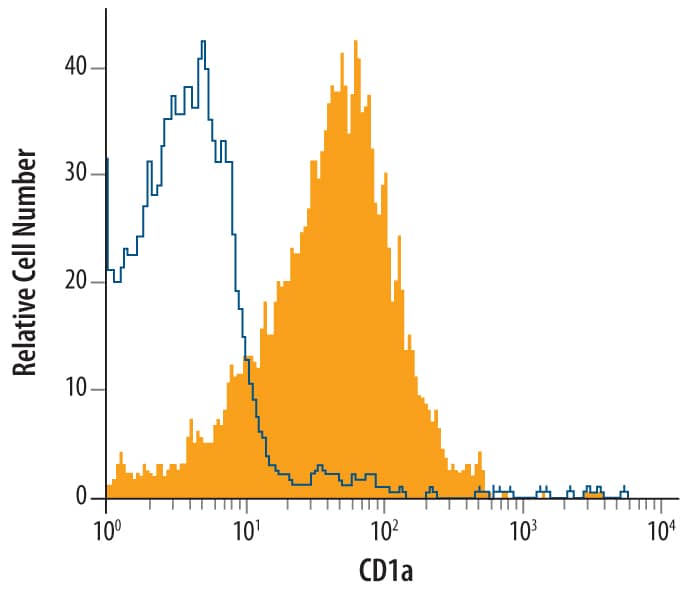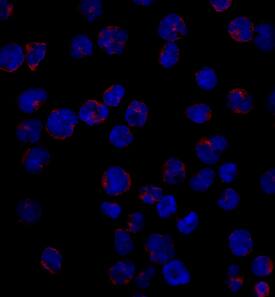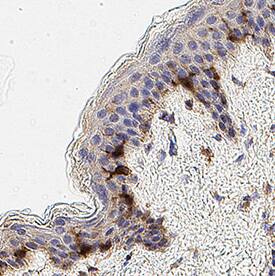Human CD1a Antibody
R&D Systems, part of Bio-Techne | Catalog # MAB7076


Conjugate
Catalog #
Key Product Details
Species Reactivity
Human
Applications
CyTOF-ready, Flow Cytometry, Immunocytochemistry, Immunohistochemistry
Label
Unconjugated
Antibody Source
Monoclonal Mouse IgG1 Clone # 703217
Product Specifications
Immunogen
Mouse myeloma cell line NS0-derived recombinant human CD1a
Asp19-Val300 (predicted)
Accession # P06126
Asp19-Val300 (predicted)
Accession # P06126
Specificity
Detects human CD1a in direct ELISAs.
In direct ELISAs, less than 5%
cross-reactivity with recombinant human (rh) CD1d is observed and no
cross-reactivity with with rhCD1b or rhCD1e is observed.
Clonality
Monoclonal
Host
Mouse
Isotype
IgG1
Scientific Data Images for Human CD1a Antibody
Detection of CD1a in MOLT‑4 Human Cell Line by Flow Cytometry.
MOLT-4 human acute lymphoblastic leukemia cell line was stained with Mouse Anti-Human CD1a Monoclonal Antibody (Catalog # MAB7076, filled histogram) or isotype control antibody (MAB002, open histogram), followed by Phycoerythrin-conjugated Anti-Mouse IgG Secondary Antibody (F0102B).CD1a in MOLT‑4 Human Cell Line.
CD1a was detected in immersion fixed MOLT-4 human acute lymphoblastic leukemia cell line using Mouse Anti-Human CD1a Monoclonal Antibody (Catalog # MAB7076) at 10 µg/mL for 3 hours at room temperature. Cells were stained using the NorthernLights™ 557-conjugated Anti-Mouse IgG Secondary Antibody (red; NL007) and counterstained with DAPI (blue). Specific staining was localized to surface and cytoplasm. View our protocol for Fluorescent ICC Staining of Non-adherent Cells.Detection of CD1a in Human Skin.
CD1a was detected in immersion fixed paraffin-embedded sections of Human Skin using Mouse Anti-Human CD1a Monoclonal Antibody (Catalog # MAB7076) at 3 µg/mL for 1 hour at room temperature followed by incubation with the Anti-Mouse IgG VisUCyte™ HRP Polymer Antibody (Catalog # VC001). Before incubation with the primary antibody, tissue was subjected to heat-induced epitope retrieval using VisUCyte Antigen Retrieval Reagent-Basic (Catalog # VCTS021). Tissue was stained using DAB (brown) and counterstained with hematoxylin (blue). Specific staining was localized to Langerhan's cells. View our protocol for IHC Staining with VisUCyte HRP Polymer Detection Reagents.Applications for Human CD1a Antibody
Application
Recommended Usage
CyTOF-ready
Ready to be labeled using established conjugation methods. No BSA or other carrier proteins that could interfere with conjugation.
Flow Cytometry
2.5 µg/106 cells
Sample: MOLT‑4 human acute lymphoblastic leukemia cell line
Sample: MOLT‑4 human acute lymphoblastic leukemia cell line
Immunocytochemistry
8-25 µg/mL
Sample: Immersion fixed MOLT‑4 human acute lymphoblastic leukemia cell line
Sample: Immersion fixed MOLT‑4 human acute lymphoblastic leukemia cell line
Immunohistochemistry
3-15 µg/mL
Sample: Immersion fixed paraffin-embedded sections of Human Skin
Sample: Immersion fixed paraffin-embedded sections of Human Skin
Formulation, Preparation, and Storage
Purification
Protein A or G purified from hybridoma culture supernatant
Reconstitution
Sterile PBS to a final concentration of 0.5 mg/mL. For liquid material, refer to CoA for concentration.
Formulation
Lyophilized from a 0.2 μm filtered solution in PBS with Trehalose. *Small pack size (SP) is supplied either lyophilized or as a 0.2 µm filtered solution in PBS.
Shipping
Lyophilized product is shipped at ambient temperature. Liquid small pack size (-SP) is shipped with polar packs. Upon receipt, store immediately at the temperature recommended below.
Stability & Storage
Use a manual defrost freezer and avoid repeated freeze-thaw cycles.
- 12 months from date of receipt, -20 to -70 °C as supplied.
- 1 month, 2 to 8 °C under sterile conditions after reconstitution.
- 6 months, -20 to -70 °C under sterile conditions after reconstitution.
Background: CD1a
Long Name
T Cell Surface Glycoprotein CD1a
Alternate Names
CD1a, FCB6, HTA1, R4, T6
Entrez Gene IDs
909 (Human)
Gene Symbol
CD1A
UniProt
Additional CD1a Products
Product Documents for Human CD1a Antibody
Product Specific Notices for Human CD1a Antibody
For research use only
